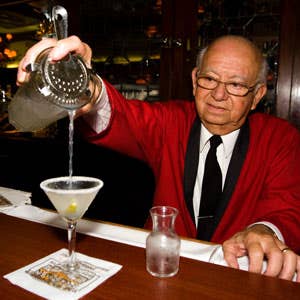
Musso and Frank has stood on Hollywood Boulevard since 1919, and virtually everything about it recalls another time. The coat racks evoke an era when people wore hats (or at least took them off in restaurants); the drinks—granddaddies of what today's mixologists make—bear hoary names like the side car and the rob roy. The wood trim-and-red Naughahide interior is elegant but subdued; a Maxfield Parish-esque mural of autumnal New England woods summons an age when a West Coast dining room was judged by how well it captured the glamour of one in the East.
The menu is unapologetically atavistic. The food has little to do with local and seasonal sourcing or with any single chef's blazing creative vision; instead, with dishes like jellied consomme and braised oxtail bourgeoise, it is drawn from a playbook passed down through dynasties of cooks. Here are stuffed celery spears, plump with blue cheese, that arrive on a bed of ice. Here are hearty daily specials—such as Tuesday's corned beef and cabbage and Wednesday's sauerbraten with potato pancakes—and dishes whose nomenclature is culled from old-line French dining: the lobster is thermidor, the sweetbreads are jardiniere, the lamb kidneys are turbigo, and the shrimp are served with a sauce poulette. All are seasoned carefully but assertively. And all are extremely good.
For me, though, the soul of the place is the waiters. Their ages are advanced, yet the term avuncular hardly comes to mind. Outfitted in red bolero jackets held closed with one button (the busboys wear a green version), they are the dignified heirs to a tradition in which being a waiter was a stately occupation. They rarely smile, and never does their tone suggest anything above a scrupulously maintained cordiality. You have to read them to communicate. The only way you might register that it is unnecessary to order the mushroom toast between the cracked crab and the club steak is to spot a momentarily stretched upper lip or a fleeting change of stance.
Founded by restaurateurs Joseph Musso and Frank Toulet and originally called Frank's Francois Cafe, Musso's has lived through entire epochs, as attested to by the names of famous patrons inscribed on bronze stars embedded in the sidewalk out front: from John Barrymore and Buck Owens to Aaron Spelling and Gene Autry. In terms of Hollywood as a cultural institution, the place has witnessed the progression from silents to talkies to color to blockbusters; in terms of Hollywood as a place, it has traversed creation, glamour, decline, neglect, and, lately, renewal.
The interior of the cream-colored building consists of two large rooms. The bar is located in the newer one (it dates from 1953), a cheery area decorated with wallpaper depicting a bucolic scene with pheasants. I prefer the older dining room, where the lighting is lower and conversation takes place against the background noise of the grill man cooking steaks behind the counter, my favorite spot for dining alone. One can sit in this environment and feel part of the past without being entombed in it. Unlike places that have logged far less time on Earth but have set up little shrines of framed clippings and photos, Musso's breezily dismisses any self-conscious evocation of its age. In this, it is true to the spirit of Hollywood, where to focus on longevity is to admit to being relegated to iconhood. —Patric Kuh, restaurant critic for Los Angeles magazine.
Keep Reading
Continue to Next Story










